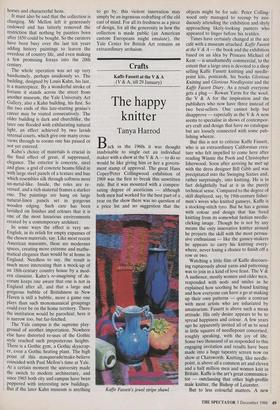Museums
The Yale Center for British Art (New Haven, Connecticut)
A bubble of Britishness
Robert Harbison
Art collections do not usually seem political, but the Yale Center for British Art is an exception to the rule. This young museum, opened in 1977, preaches an underlying text which is deeply un-young.
The founder, Paul Mellon, Yale College Class of 1929, is the son of Andrew Mellon, successful banker and member of Coolidge's cabinet, whose collection formed the nucleus of the National Gallery in Washington. The fortune came from Pittsburgh, and many of the best paintings came from Stalin, who was selling off Raphaels and Rembrandts from the Her- mitage to get foreign currency.
While Mellon Senior was amassing these treasures, his son was at Cambridge soak- ing up English culture. The Yale Center is about an American love affair with Eng- land, which began in the difficult 1930s but made its home in the 18th century. Paul Mellon's amazing collection, which must be the best and most comprehensive out- side the Tate of earlier English painting, has very little of the 19th or 20th centuries. Nominally it stops at Turner, but the real core is much earlier, in Stubbs, Wright, and Gainsborough.
It leaves one's feelings curiously divided: Mellon's eye is a modern eye — Stubbs and Wright of Derby are the Vermeer and Latour of English painting, which is to say newly seen and valued for analytical power that inheritors of 20th-century abstraction are primed to appreciate. In that respect it is a collection no 18th-century squire could have assembled. Still, it is bizarre to find in 1988 such a concentration of topographical views and animal paintings, interspersed with portraits of comfortable gentlemen and their wives. Of course the collection sometimes upsets our preconceptions: the marvellous Elizabethan portraits are not a pedigree dragged pompously along behind, the refuse of family history, but a conscious choice. Yet they may still be, in some abstract sense, 'ancestral', Mr Mellon pro- viding anterooms leading up to his central prizes. And although one has a surfeit of hunting scenes and bird's-eye views (in New Haven, to be sure, this genre is not as pat as it would be in Northamptonshire), one is made to re-see such apparently limited workers as James Ward, whom we now suspect of moralising his muscular
horses and characterful hens.
It must also be said that the collection is changing. Mr Mellon left it generously endowed and has latterly removed the restriction that nothing by painters born after 1850 could be bought. So the curators have been busy over the last ten years adding history paintings to leaven the overdose of country life, and even making a few promising forays into the 20th century.
The whole operation was set up very handsomely, perhaps insidiously so. The building, designed by Louis Kahn, his last, is a masterpiece. By a wonderful stroke of fortune it stands across the street from another museum, the Yale University Art Gallery, also a Kahn building, his first. So the two ends of this late-starting genius's career may be visited consecutively. The older building is dark and churchlike, the later one flooded with exhilarating natural light, an effect achieved by. two lavish internal courts, which give one many cross- views through to rooms one has passed or not yet entered.
Kahn's choice of materials is crucial in the final effect of great, if suppressed, elegance. The exterior is concrete, steel and glass: a grid of concrete beams filled in With large steel panels of a texture and hue which resembles silk through softness most un-metal-like. Inside, the roles are re- versed, and a rich material frames a starker one. The paintings are hung on large natural-linen panels set in gorgeous wooden edging. Such care has been lavished on finishes and colours that it is one of the most luxurious environments created by a contemporary architect.
In some ways the effect is very un- English, in its relish for empty expanses of the chosen materials, say. Like mostrecent American museums, these are modernist spaces, creating more extreme and mathe- matical elegance than would be at home in England. Needless to say, the result is much more interesting than a mock-up of an 18th-century country house by a mod- ern classicist. Kahn's re-imagining of de- corum keeps one aware that one is not in England after all, and that a large and gorgeous bubble of Britishness in New Haven is still a bubble, more a game one plays than such monomanaical groupings could ever be on the home territory. There the institution would be parochial; here it is narrow too, but far-fetched.
The Yale campus is the supreme play- ground of another importation. Nowhere else have distorted re-uses of the Gothic style reached such preposterous heights. There is a Gothic gym, a Gothic skyscrap- er, even a Gothic heating plant. The high point of this masquerade/make-believe coincided with Paul Mellon's time at Yale. At a certain moment the university made the switch to modern architecture, and since 1965 both city and campus have been peppered with interesting new buildings. But if the later Kahn museum is anything to go by, this violent innovation may simply be an ingenious redrafting of the old cast of mind. For all its freshness as a piece of design, for all the generosity in how the collection is made public (an American custom Europeans might emulate), the Yale Center for British Art remains an extraordinary archaism.



































































 Previous page
Previous page